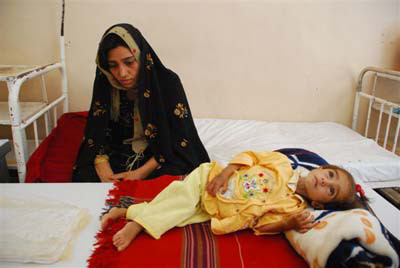By Shannon Galpin
You would think there would be more of an uproar in a country with the highest maternal death rates. No other country in the world loses more women in childbirth than Afghanistan. None. Rarely has being first at something meant so much loss.

Afghanistan has the second highest maternal mortality rate in the world according to a UN report in 2009. (Photo: Agustinus Wibowo/CRS)
It's not just the women either, lest you callously chalk it up to the inevitable argument over women's oppression in a country like Afghanistan, where women set themselves on fire to escape arranged marriages, rapists go free, victims go to jail, and women die in childbirth when a male doctor lives just 10 minutes down the road because he is unable to view her naked or worse yet, touch her below the belt.
The children, too, are dying at alarming rates. Skirting at the top of the heap, currently in the second position, is the highest infant death rate in the world. Babies die from suffocation when a nasal suction would clear out their mouth and nose post-delivery. Babies die of dehydration when they are given dirty water instead of breast milk. Babies die of common colds due to harsh winters with little to keep them warm.
All of these causes are easily rectified, as are many of the major causes of mother's deaths during delivery: dirty knives used to cut the umbilical cord, causing infection, and the inability to deliver the placenta, which causes the woman to bleed out.
Lack of a few simple medicines, lack of pre- or post-natal care, and lack of female doctors leads to death on a large-scale. This is a country already suffering from something akin to country-wide post traumatic stress disorder due to nearly four decades of war and the incredible loss of life that has affected every family. In short, many of these deaths are preventable. Families crave midwives.
Currently, midwife training schools exist in nearly every province in order to alleviate this situation and the Afghan Minister of Public Health touts its success. Successful for cities and larger communities, yes. But, this two year program rarely spreads far beyond the largely populated areas.
Lack of education makes a trickle-down effect nearly impossible. A unique village-to-village approach is needed to save lives in rural communities. The reason? Girls must have a 9th grade education to attend midwife training. Those that have the education, must then have the permission from their father or husband to leave their community for two years to attend training. In the rare case that education, permission, and scholarship are available, a young woman will most likely return to her community to live after finishing school. This is a wonderful solution for that village, and she will do much for her community's welfare, but what about the communities that don't have educated girls to send? It is extremely rare that a girl would return from school to a village other than her own. So, the villages that don't have girls educated to the 9th grade, a rarity in many areas across the country, have no hope to train girls from within their own village.
So, the solution? Train women and girls with low levels of education, to be skilled birth attendants. Teach them the simple solutions that save lives that you or I could learn in four short weeks. Teach them basic sanitation and have them educate their village. Teach them how to administer basic medicines and vaccinations. Pay them a small stipend to work in their village. As the village thrives, and the women earn money for their family, the value of women increases and deaths decrease.
A great example of this cultural shift occurred in a remote mountain village in the Panjshir. We had ongoing discussions about building a girl's primary school, and the elders were reticent. When we shared our other program, rural midwife training, their eyes lit up and questions and stories flew around the room as I struggled to keep up with their pace. Upon realizing that we couldn't train illiterate women, and the knowledge that there wasn't one single literate woman or girl in the village, we ended the discussion. The next morning, fifteen men met me with green tea and said they would like to pursue the original discussion of a girls school.
Often it's illustrating the way girls and women can contribute to the general welfare of the community that makes the rational argument for their health, worth, and their education.
Our next training begins with women from two Taliban-controlled provinces, where women have long suffered under oppression, but where, even there, the lives of women and their offspring have value enough to save, but no one to save them.
Until now.



